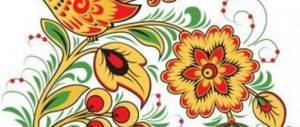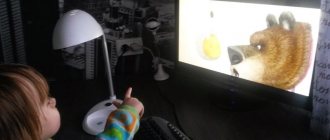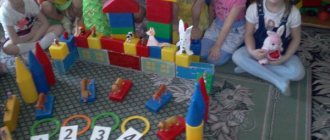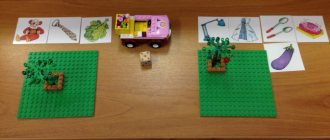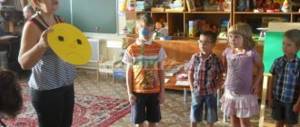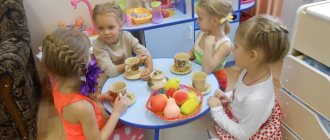Project in the senior group “Opening the Red Book of Russia”
Objective of the project:
introduce children to the Red Book of Animals of the Russian Federation and species of rare (endangered) animals; with the concepts of “habitat”, “food chain”, with the work of zoos and reserves to preserve rare species of animals; to give an idea that nature is a single living organism in which all animals and plants are important (there are no good or bad ones); to cultivate a caring attitude towards nature: nature is diverse, but fragile and not limitless, it must be protected and preserved.
Lesson No. 1 “Opening the Red Book.”
Objectives: familiarization with the Red Book, the concept of “rare animal”.
View the presentation “Animals from the Red Book”.
During the lesson, the guys and I watched the presentation and had a conversation. The children were surprised at how many animals they know were included in the Red Book. The term “rare animal” was explained. The children were asked a problematic question: why are there fewer animals? (Animals have little food, animals have nowhere to live, animals are hunted). At the end of the lesson, the conclusion was made that rare animals need to be saved.
In the evening, watch the cartoon “The Red Book” (animated series “Smeshariki”).
Lesson No. 2 “Habitat”.
Objectives: familiarization with the concept of “habitat”, what it is; explain why animals live only in certain habitats, why habitats disappear, how people can help animals survive.
View the presentation "Habitat".
During the lesson, while showing the presentation, the term “habitat” (the place where the animal lives, hunts, and breeds) was explained to the children. The habitat may disappear, then the animals have nowhere to live and nothing to eat. Habitats can disappear due to natural disasters (for example, a forest fire) or due to destructive human activities (air and water pollution; deforestation and construction of houses and roads in their place). Conclusion: the habitat of animals must be treated with care: assess the harm and benefits that a change in the habitat can bring.
In the second part of the lesson, children were shown pictures with various habitats: forest, swamp, sea, field, tundra (permafrost), etc. After this, the game “Who lives where?” was played.
Pictures with different animal habitats were displayed on the board, and the child had to “place” the animal from the pictures in its habitat.
Conducting the didactic game “Who Lives Where?” (meadow-butterfly, Arctic - walrus, swamp - heron, forest - badger).
Lesson No. 3 “Food chains”.
Objectives: to introduce children to the concepts of “predatory animal”, “herbivore”, explain the relationship between predatory and herbivorous animals, mutual benefit; explain the concept of “food chain”; During the game, bring the children to the conclusion that if one of the links in the food chain disappears, then the whole chain is destroyed.
View the presentation “Carnivorous and herbivorous animals. Food chains".
While watching the presentation, it was explained to the children that predatory and herbivorous animals can be distinguished by their teeth: a predatory animal has sharp teeth (fangs), since they need to hunt, while herbivores have blunt teeth, they use them to chew grass, bark, and leaves. Herbivores are food for carnivorous animals. But in nature there are no “bad” and “good”, “evil” and “good” animals, they all bring benefits. Herbivores promote plant growth, while carnivores hunt primarily old and weak animals, helping the strong and healthy to survive. Plants, herbivores and carnivorous animals are combined into a food chain: plants are food for herbivores, herbivores are food for predators.
In the second half of the lesson, the game “Make a food chain” was played. Children were given pictures on their tables with paper clips (chain links) attached to them. The children had to determine who was eating what (whom) and connect the chain correctly. After making the chains, the children, at the request of the teacher, covered one of the animal pictures with their hand and explained what would happen if one or another animal disappeared (if there were no mosquitoes, the frogs would starve, etc.). In this way, children were led to the idea that there are no “extra” or “bad” animals in nature. They are all important and they all bring some benefit to each other.
At the end of the lesson, the children were offered models to represent carnivorous (a triangle in a circle - a sharp tooth) and herbivores (a rectangle in a circle - a blunt tooth) animals.
Food chains collected by children.
Lesson No. 4 “How people save rare animals.”
Objective: to give children an idea of working in zoos and reserves to preserve rare species of animals; concepts of “reserve”, “bird ringing”, “animal capture”.
View the presentation “How people save rare animals.”
While watching the presentation, the children were told about the work of people in zoos and nature reserves. The zoo breeds animals in captivity. They can no longer be returned to the wild, but they can survive near people. A reserve is a huge area of wild nature where any human activity to change it is prohibited (deforestation, drainage of swamps, construction of houses, etc.). In nature reserves, scientists study wild animals and help them survive (they count the animals, feed them in winter, and make sure that the animals do not get sick). When there are many animals in the reserve, they are caught and transported to another reserve, where there are few such animals. Scientists ring birds to track where these birds fly in winter and where they bear offspring. Then the children were explained the rules of behavior in the zoo (do not feed the animals, do not knock on the glass, do not make noise) and in the reserve (you cannot tear plants, you must walk along the paths, you must not make noise, etc.).
At the end of the lesson, the children were shown models that will indicate in Our Red Book: “you cannot hunt,” “the animal is protected in the reserve.”
Throughout the project, in the evenings there was a screening of the BBC documentary “Climate Zones of the Earth. Habitat".
The knowledge acquired by children in classes to familiarize themselves with the world around them was supported in classes on productive activities.
Application – “Polar bears on an ice floe”.
Construction – “We are building a zoo.”
Modeling - “My favorite animal from the Red Book.”
The result of the project activity is the creation of the Red Book of Animals for the group.
Goal: to create a manual that children and group teachers could use.
In order for children to be able to “read” the book on their own, a modeling method was used. All models were explained to the children during the entire project in class. For educators, a page with the necessary material has been made about each animal.
Children “read” Our Red Book.
Authors: Botkina Svetlana Sergeevna,
Klyagina Daria Borisovna,
teachers of GBOU secondary school No. 349 in Moscow
(preschool department No. 1205)
The article is published in the author's edition
Ecology lesson "Introduction to the Red Book of the Belgorod Region"
Ecology lesson “Introduction to the Red Book of the Belgorod Region”
TOPIC: Red Data Book of the Belgorod Region.
GOAL: Introducing children to the Red Book of the Belgorod Region.
Program content:
1. Introduce children to the purpose, general content and design of the Red Book of the Belgorod Region.
2. To arouse in children a desire to master the skills and abilities of certain methods of nature conservation.
3. To develop cognitive and speech skills in children that are relevant to the content of the lesson: the ability to compare, generalize and denote actions in words.
Equipment: Red Book of the Belgorod Region, posters on nature conservation, pen and sheet of paper for recording children's stories.
Methodological techniques: teacher's story, reading of poems by children and the teacher, showing illustrations of the Red Book, creative storytelling by children on the topic: “How I helped nature” (recording children's stories for a future book).
Preliminary work: acquaintance in the senior group with the Red Book of the Russian Federation, reading poems about nature, getting acquainted with posters about nature conservation, excursions and walks into nature.
Progress of the lesson:
Part 1 of the lesson.
- Children, look at this book. This is the Red Book of the Russian Federation. I have already shown you this book and told you about it. Who remembers what this book is about?
“It lists the animals and plants that need to be protected.
- Yes, this book describes those animals, plants, mushrooms, the fish of which are few in our country, and they must be protected. Do you think there are such plants and animals in our region or our village?
- Eat.
- Which ones? (Children find it difficult to answer). I also didn’t know what plants and animals were becoming scarce in our country until I came across one very interesting book. It is called the Red Book of the Belgorod Region. (Teacher shows). Here she is. Are you already familiar with the name The Red Book and have probably guessed what and who is written in it?
— About those plants and animals that are few in our region.
- Right. About those species of animals, plants, fish, birds that need to be protected, since their numbers are decreasing.
- Let's open it and take a look. On each page there are photographs of plants, animals, reptiles, birds, fish and it is written why they are disappearing, and how people can help nature survive.
— Why do you think it is necessary to preserve endangered species of plants and animals? (The teacher listens to different versions of the children). Yes, you are right, without any disappeared animals and plants, life on our Belgorod land will become poorer. Listen to what the governor of our region, Evgeny Savchenko, wrote in the Red Book:
“The expanses of our beloved Belogorye are amazingly attractive: the smooth slopes of the hills and the bizarre bends of the beams, the calm flow of rivers, and the lively murmur of the purest springs. Snow-white chalk steeps and “soft” emerald meadows, curly “forelocks” of protected oak forests and the transparent tenderness of birch groves. This is our beautiful little homeland. But in just one generation, 26 species of animals and more than 10 species of plants have disappeared in the Belgorod region. That’s why the Red Book of the Belgorod Region was created.” The governor says that every person should protect those plants and animals that are listed in this book. But first you need to know what kind of plants and animals these are. And we will get to know them in class.
Physical education minute. Now we will relax and play. The game is called "Show". I will name animals, insects or birds, and you will show them with movements of the body, arms and legs. For example, show a bear. (Children show). Children standing show: hare, sparrow, crucian carp, dragonfly, etc.
Part 2 of the lesson.
— I said that many insects, plants, animals, birds, fish, mushrooms, and mosses are listed in the Red Book. Now we’ll play some more and remember how they differ from each other. The game is called “Who is bigger? " We are divided into two teams and will take turns naming the characteristics of different natural species. For example: mushrooms.
The first team - ... often live in the forest;
The second is... they have caps and stems, etc.
The last team to name the sign wins a point.
— Tell me, where have you seen or heard about the need to protect nature?
— They spoke on TV, on the radio, there are special posters.
—Where are such posters placed?
- On the streets, at the entrance to the forest, to the park, in some institutions, in schools.
— Here's a look at some posters whose authors call for protecting nature. I propose to draw such a poster and place it in kindergarten. (Children begin to do collective work “Nature Conservation”. You can finish it in the afternoon or at home with your parents. A common poster is displayed in kindergarten).
- So, what did we talk about in class today?
— About the Red Book of the Belgorod Region.
- And we will talk about specific animals and plants in this book in the next classes.
